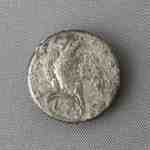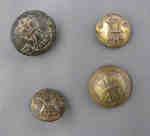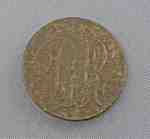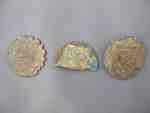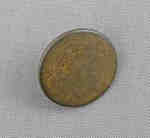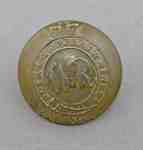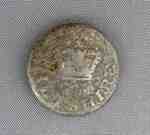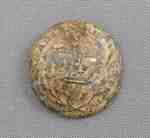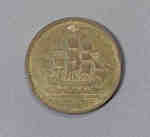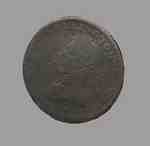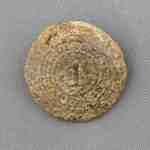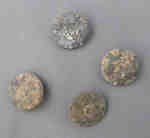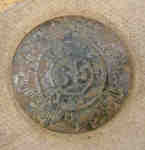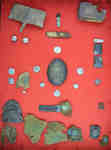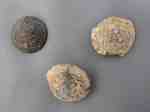Résultats
- United States of America Infantry button made of white metal with an eagle on a branch and “US” in an oval below. The shank is bent on the reverse. The button diameter is 1 cm.United States of America Infantry button made of white metal with an …
- A British infantry regiment that was raised in 1751 and amalgamated with the 52nd (Oxfordshire) Regiment of Foot, to form the Oxfordshire and Buckinghamshire Light Infantry in 1881. It is believed thA British infantry regiment that was raised in 1751 and amalgamated with …
- Button has letters R.R intertwined with no shank on the reverse. Diameter is 1.5 cm.Button has letters R.R intertwined with no shank on the reverse. Diameter …
- Buttons have three raised cannon balls in a horizontal row across the top and three raised cannons in a vertical row that are set in a shield. It is believed that this button is from the War of 1812.Buttons have three raised cannon balls in a horizontal row across the …
- A plain button, believed to be from the 1812 era, that has “Stand(D) Gold Col(R)” inscribed on the reverse.A plain button, believed to be from the 1812 era, that has …
- A Royal Sappers and Miners button believed to be from the War of 1812 era. There was no overall commanding officer but there was a battalion from July 1812 to February 1815. It is believed that theyA Royal Sappers and Miners button believed to be from the War …
- The button is believed to be made of pewter and has a raised “WILTSHIRE” on the face along with a crown in the centre. The diameter is 2.2cm. The 1st Battalion of the 62nd Regiment arrived in HalifaxThe button is believed to be made of pewter and has a …
- It is believed that this is a Canadian Regiment of Fencible Infantry button from the 1812 period. Enlistment for the Fencibles started in 1805 in both Upper and Lower Canada. By the War of 1812 theyIt is believed that this is a Canadian Regiment of Fencible Infantry …
- This is a copper token coin that has Ships, Colonies and Commerce written on one side and three masted schooners facing left on the other with a beaded rim. The coin measures 2.5 cm in diameterThis is a copper token coin that has Ships, Colonies and Commerce …
- This copper coin is inscribed “Wellington” with a profile of Lord Wellington on one side. The reverse side has a laurel wreath with Britannia seated. It is a Wellington half penny, dated 1814 and isThis copper coin is inscribed “Wellington” with a profile of Lord Wellington …
- An infantry unit that was recruited from the British Colonies of the Caribbean around 1795. It is believed this regiment was made up of freed North American and Caribbean slaves. During the War of 18An infantry unit that was recruited from the British Colonies of the …
- These are buttons from the 41st Regiment of Foot that served in the Canada during the War of 1812. The design is a “41” raised in the center of an eight point star.These are buttons from the 41st Regiment of Foot that served in …
- One researcher has changed our initiate identification to that of the 85th (Bucks Volunteers) Light Infantry. The numerals in the center are encircled by a belt, on which is written "BUCKS", which yoOne researcher has changed our initiate identification to that of the 85th …
- A varnished wood bootjack that was discovered at the Lundy’s Lane Battlefield.A varnished wood bootjack that was discovered at the Lundy’s Lane Battlefield.
- t has “70” raised in the centre surrounded by a raised laurel wreath. “SURRY” is also raised across the top of the button. This regiment was raised in 1782 and sailed from Cork, Ireland to Lower Canat has “70” raised in the centre surrounded by a raised laurel …
- A button of the 70th Surry Regiment that is 1.9 cm in diameter. It has “70” raised in the centre surrounded by a raised laurel wreath. “SURRY” is also raised across the top of the button. This regimeA button of the 70th Surry Regiment that is 1.9 cm in …
- This regiment was formed in 1758 and was amalgamated into The Hampshire Regiment in 1881.This regiment was formed in 1758 and was amalgamated into The Hampshire …
- These artifacts are mounted on red felt to the back of its case (A). The items are (from left to right): B. A piece of an unidentified metal object that looks like a scraper and two musket balls C. RThese artifacts are mounted on red felt to the back of its …
- A British infantry regiment that was raised in 1751 and amalgamated with the 52nd (Oxfordshire) Regiment of Foot, to form the Oxfordshire and Buckinghamshire Light Infantry in 1881. It is believed thA British infantry regiment that was raised in 1751 and amalgamated with …
- A white clay pipe with just the bowl and no markings. It measures 6 cm in length and the bowl is 1.5cm in diameter. A portion of the stem is said to have been excavated at Fort George in Niagara-on-tA white clay pipe with just the bowl and no markings. It …





